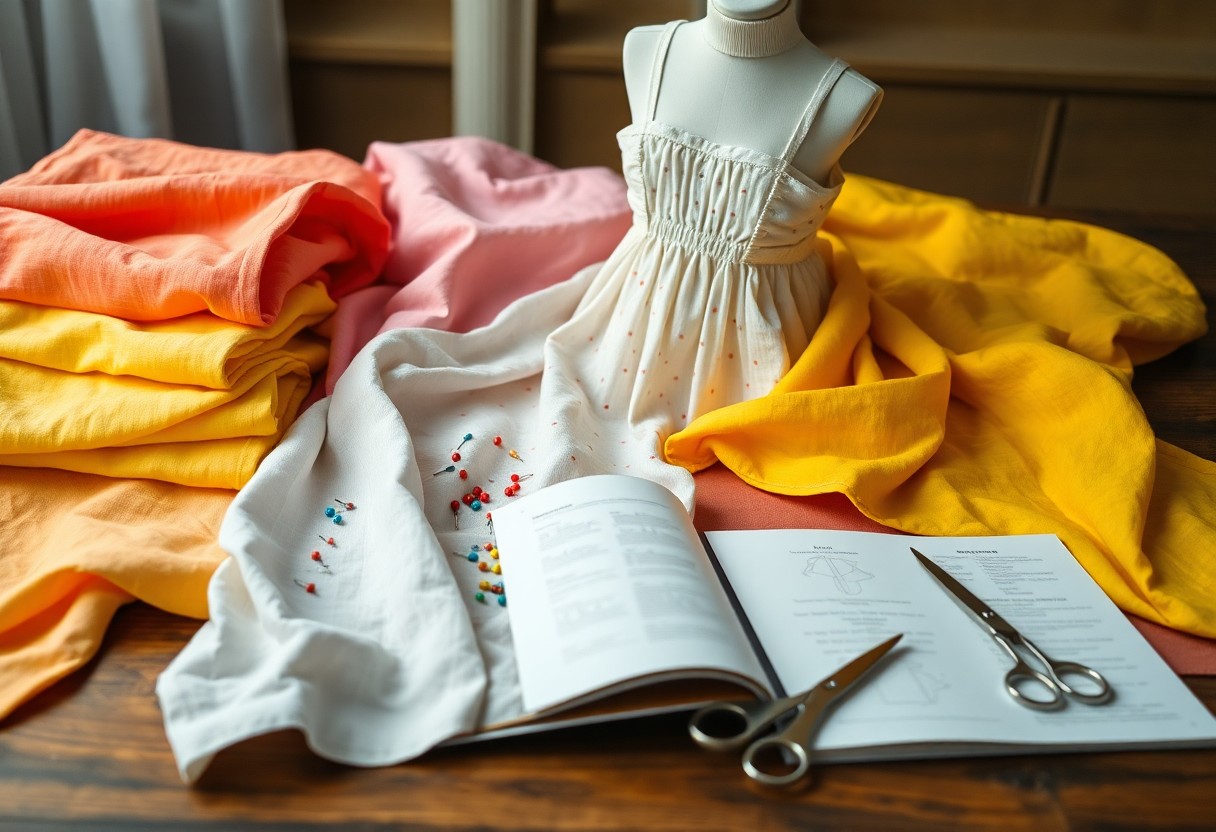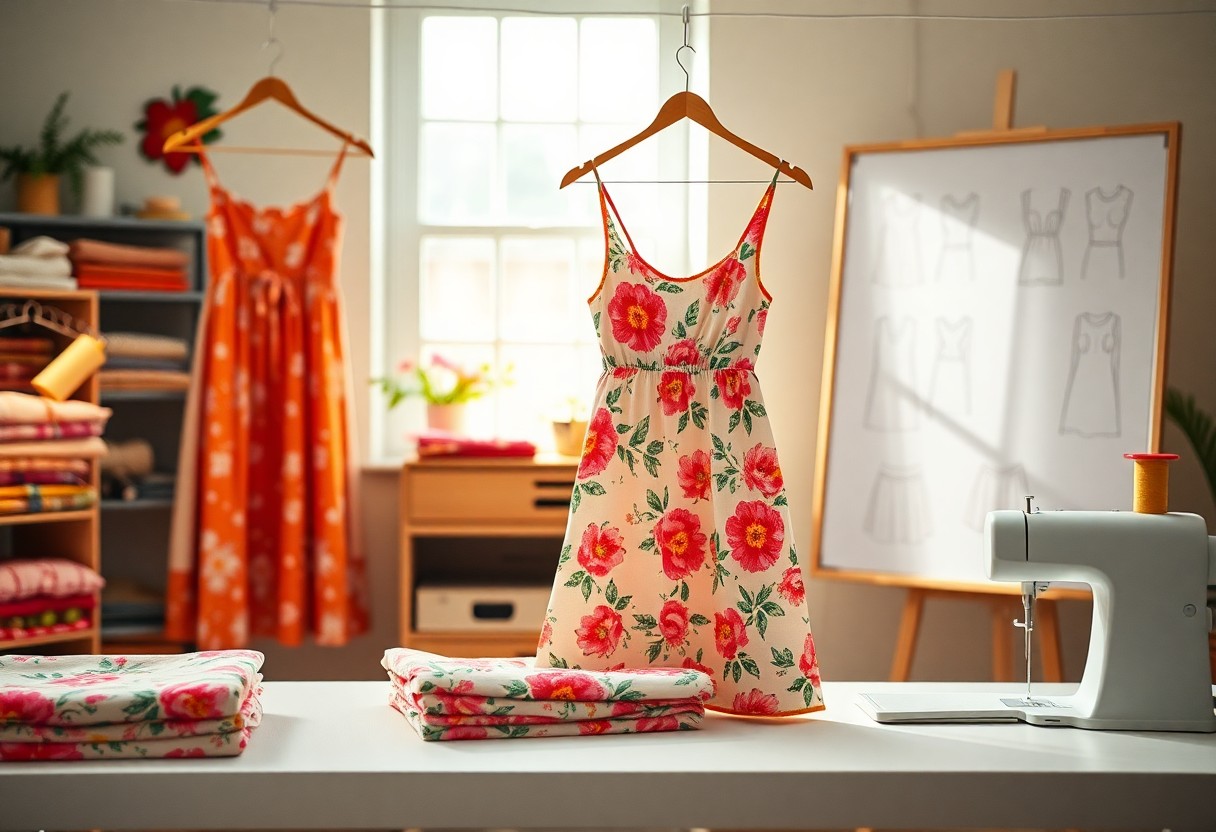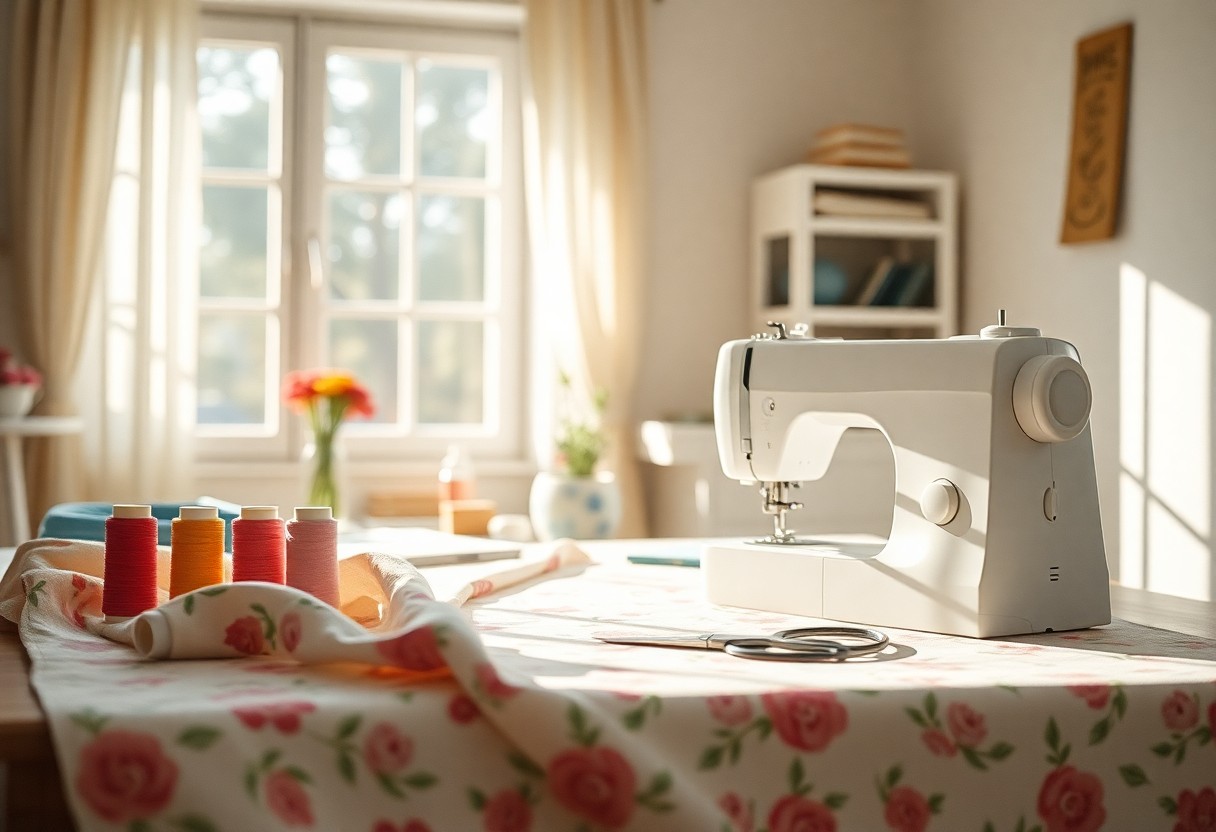There’s a world of creative possibilities waiting for you this summer with lightweight fabrics and breezy patterns. As the temperatures rise, choosing the right materials can make all the difference in comfort and style. This guide will help you explore ideal fabrics, such as cotton, linen, and rayon, along with trendy patterns that keep your sewing projects fun and functional. Get ready to elevate your summer wardrobe with pieces that are as breezy as the season itself!

The Allure of Lightweight Fabrics
Lightweight fabrics are your best friends during sweltering summer days, helping you stay cool while looking stylish. These materials allow for breathability, ensuring comfort without sacrificing aesthetics. From delicate cotton voiles to airy linen blends, lightweight fabrics provide versatile options for a range of sewing projects. Their natural drape enhances the flowy patterns you crave, making it easy to create garments that capture the summer’s essence effortlessly.
Choosing the Right Materials for Summer
Selecting the ideal materials involves understanding the characteristics that define lightweight fabrics. Opt for fabrics like cotton lawn, known for its soft feel, or rayon, which offers a beautiful drape and coolness. You may also consider muslin for its airy quality or batik for vibrant prints. Each fabric has unique qualities that cater to your summer sewing preferences, ensuring comfort and style in every stitch.
Performance and Comfort: A Fabric Comparison
A direct comparison of popular lightweight fabrics reveals significant variations in performance and comfort. For instance, linen excels in breathability and moisture-wicking, while rayon offers a luxurious touch. Conversely, cotton lawn combines softness with durability, making it ideal for wear. Understanding these differences will guide your decisions, ensuring your creations are suited for summer’s heat.
| Fabric Type | Characteristics |
|---|---|
| Linen | Highly breathable, moisture-wicking, crisp texture |
| Rayon | Soft, luxurious feel, drapes beautifully |
| Cotton Lawn | Lightweight, durable, smooth finish |
| Muslin | Very lightweight, often used for toiles |
| Batik | Vibrant prints, airy, suitable for summer |
Analyzing the performance and comfort of various fabrics helps you make informed choices that enhance your sewing experience. For example, linen’s moisture-wicking properties make it ideal for hot weather, while rayon’s softness adds an element of luxury. Cotton lawn strikes a balance between durability and elegance, allowing for long-lasting wear. Each fabric offers distinct advantages, so assessing your needs for specific projects will ultimately lead you to the perfect material.
| Fabric Type | Best Uses |
|---|---|
| Linen | Summer dresses, lightweight trousers |
| Rayon | Flowy tops, skirts, and formal wear |
| Cotton Lawn | Shirts, sundresses, and children’s clothing |
| Muslin | Pattern making, lightweight liners |
| Batik | Statement pieces, casual wear |
Breezy Patterns That Beat the Heat
Your summer wardrobe thrives on patterns that allow airflow and movement. Look for styles featuring loose cuts, unstructured designs, and playful prints. Fabrics like cotton lawn, lightweight linen, and rayon should be your go-to choices. These materials not only keep you cool but also add a sense of whimsy to your outfits, perfect for sun-filled days and warm evenings. Embrace floral motifs, geometric shapes, or islands of color to elevate your aesthetic while staying comfortable.
Flowing Silhouettes: What to Look For
Opt for flowing silhouettes that enhance breathability and comfort. Maxi dresses and relaxed-fit tops allow for freedom without sacrificing style. Choose wide-leg pants or tunic blouses crafted from lightweight fabrics, ensuring they’re not too close to the body. Features like ruffles, tiered hems, or flared designs create movement, providing a sense of effortless grace even in high temperatures.
Evaluating Style Versatility for Summer Wardrobe
Versatility in your summer wardrobe makes it easier to mix and match outfits for various occasions. Look for pieces that can transition from casual daywear to evening events with minimal effort. A simple linen dress, for example, can be dressed up with statement jewelry or down with sandals. Aim for items that harmonize with your existing closet, allowing you to create multiple looks without excessive purchases.
Prioritize items that seamlessly integrate into your current wardrobe, making outfit planning hassle-free. Versatile pieces often feature neutral colors or classic styles, allowing for easy layering and pairing. Accessories play a significant role in transforming your look; a lightweight scarf or a bold belt can shift a day outfit to evening elegance. Investing in staples like a wrap dress or versatile culottes ensures you maximize your style options while keeping comfort at the forefront.
Essential Techniques for Sewing Lightweight Fabrics
Mastering lightweight fabrics enhances your summer sewing projects. Techniques such as adjusting your machine’s tension, opting for the right *needles*, and using *interfacing* will elevate your sewing game. Focus on fine, smooth stitches to avoid puckering and ensure your creation is as breezy as it looks. Delicate materials often require special handling; learning the best practices can make a significant difference.
Tips for Handling Slippery Materials
Handling slippery fabrics can challenge even seasoned sewists. Use *pattern weights* instead of pins to avoid shifting layers, and consider *stabilizers* to maintain shape. A walking foot prevents fabric from slipping while sewing, and sewing with a longer stitch length minimizes the risk of puckering. Pressing lightweight fabrics before cutting can help keep them in place. Knowing these tips will make your sewing experience smoother and more enjoyable.
Stitch Selection for Optimal Results
Selecting the right stitch when working with lightweight fabrics can transform your final product. For example, a *zigzag stitch* provides stretch without breaking threads, while a *straight stitch* forms a clean line. Adjusting stitch length and width enhances both function and style. A narrow *French seam* gives a polished look, perfect for summer tops and dresses. Testing stitches on scrap fabric can ensure the best results.
A key consideration for stitch selection involves both the type of fabric and the intended garment use. For sheer fabrics, a *narrow hem* stitch or rolled hem keeps edges neat without adding bulk. Fabrics like chiffon or silk respond well to lighter stitches, maintaining elasticity and drape. Keeping your *sewing machine* settings, such as thread tension and presser foot pressure, optimized for lightweight materials is crucial for achieving a professional finish. Ultimately, an understanding of stitch properties allows you to customize your techniques for each project and results in garments that look beautifully tailored.
Creative Summer Projects to Spark Inspiration
In the spirit of summer, explore projects that are not only fun but also foster your creativity. Consider tackling ideas that blend *functionality* with *fashion*, perfect for those warm days ahead. Think about incorporating *bright colors*, *playful patterns*, and *easy-to-wear designs* that reflect your unique style. These projects will invigorate your sewing practice while providing refreshing additions to your wardrobe.
Must-Try Patterns for Beginners
Beginner sewists will find joy in patterns that prioritize simplicity and ease of assembly. Start with items like *tank tops*, *beach cover-ups*, and *simple skirts* that require minimal sewing techniques. These projects not only boost your skills but also allow you to experiment with *lightweight fabrics*, making the learning process both enjoyable and rewarding.
Advanced Projects for the Experienced Sewist
For those with a wealth of sewing experience, summer offers the chance to challenge your skills further. Consider creating garments that feature unique elements like *draped silhouettes*, *intricate embroidery*, or *layered looks*. Projects such as tailored shorts, *flowy dresses*, or garments incorporating *mixed fabrics* can deepen your mastery while resulting in stunning summer staples.
Essential Advanced Projects
| Project | Description |
| Layered Maxi Dress | Flattering design that showcases mixed fabrics for a breezy look. |
| Structured Shorts | Tailored fit with pockets and a stylish waistband for a polished appearance. |
| Embroidered Blouse | Intricate detailing that adds sophistication to your summer outfits. |
Advanced projects allow you to express your personal style while refining your techniques. Engaging in *draping*, *tailoring*, and *embellishments* not only enhances your portfolio but also challenges your creativity. Focus on integrating detailed finishes and considering the fabric properties to achieve that coveted summer look.
Advanced Project Ideas
| Project | Skills Required |
| Jumpsuit | Complex construction, zippers, and tailored fit. |
| Breezy Kimono | Layering techniques and fabric manipulation for flow. |
| Quilted Beach Bag | Utilizing batting and advanced sewing techniques for durability. |

Personal Expressions: Customizing Your Summer Wardrobe
Your summer wardrobe can truly reflect your personal style through thoughtful customization. By incorporating unique patterns and colors, you transform standard garments into eye-catching pieces. You have the freedom to choose styles that fit your lifestyle, whether that’s playful prints or sophisticated solids. This season, embrace bold choices—layer textiles, experiment with lengths, and curate a collection that feels authentically you.
Embellishments and Add-Ons for a Unique Touch
Add personality to your creations with embellishments like beaded trims, hand-stitched appliqués, or fabric paints. These small details can elevate a simple garment into something extraordinary. Consider using contrasting fabrics for pockets, cuffs, or collars to create striking visual interest. A few thoughtful additions can turn basic pieces into unique statements, ensuring your summer outfits stand out.
Techniques for Fabric Mixing and Matching
Mixing and matching fabrics allows you to craft a wardrobe that’s both interesting and cohesive. By selecting fabrics with different textures, like pairing lightweight cotton with breathable linen, you achieve a dynamic aesthetic. Focus on color harmony; choose a unifying palette, or experiment with complementary hues to bring your ensemble together. This approach not only enhances your creativity but also maximizes the wearability of your summer collection.
Combining fabrics effectively starts with understanding their properties. For instance, consider drape and weight; lighter fabrics like voile pair well with structured materials like denim for balance. Try using a patterned fabric for one garment section while maintaining a solid for another, ensuring to maintain consistency with colors and motifs across your pieces. This strategic layering not only brings depth but also showcases your sewing expertise. Pay attention to scale as well; mix large prints with smaller ones to create visual intrigue without overwhelming the design.
Summing up
Conclusively, integrating lightweight fabrics and breezy patterns into your summer sewing projects will elevate your wardrobe while ensuring comfort in warmer temperatures. By selecting breathable materials and embracing airy designs, you can create stylish and functional pieces that reflect your personal style. Utilize this season’s trends to enhance your sewing skills and enjoy the satisfying experience of making your own summer importants. With your creativity and these tailored choices, you will craft garments that not only look good but also keep you cool and comfortable throughout the hot months.
FAQ
Q: What are some lightweight fabrics suitable for summer sewing projects?
A: Some lightweight fabrics ideal for summer projects include cotton, linen, rayon, and voile. These materials are breathable and allow for comfort during hot weather.
Q: What types of patterns work best with lightweight fabrics?
A: Breezy patterns such as loose-fitting dresses, lightweight tops, and flowing skirts complement lightweight fabrics. Choose designs with less structure to take advantage of the fabric’s drape.
Q: How do I properly care for lightweight fabrics after sewing?
A: To care for lightweight fabrics, wash them on a gentle cycle with cold water, avoid harsh detergents, and air dry when possible. For best results, always refer to the specific care instructions for the fabric used.
